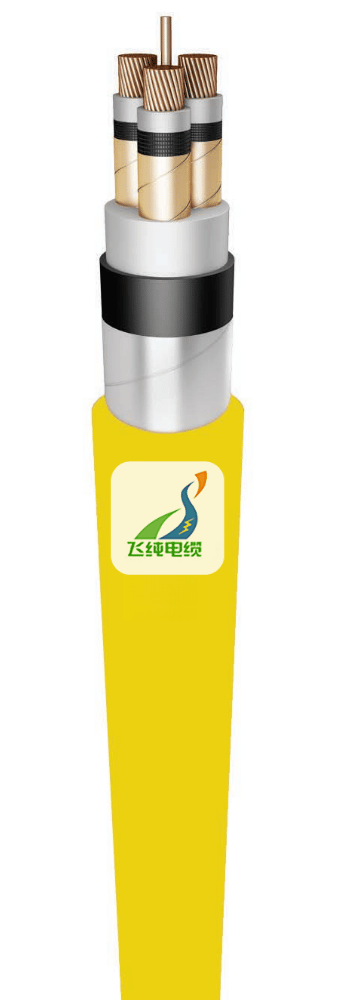Type YHKGYFtlyn 0.6/1 kV Mining Power cables
Flame retardant PVC coated mining power cable with individually shielded copper conductors
With radial field, PVC insulation, PVC sheath, armor tape
Painted steel with flame retardant PVC coating


Type YHKGYFtlyn cable is a flame-retardant mining power cable designed for low-voltage applications (0.6/1 kV) in the challenging environments found in underground mines.
It is engineered to reliably transmit electrical energy under harsh climatic and mining conditions while providing enhanced safety features through robust construction and fire-resistant materials.
Construction and Materials
1. Conductor System
Copper Conductors:
The cable uses round, multi-stranded copper conductors that are compacted to Class 2, manufactured according to PM-EN 60228 standards.
Individual Shielding:
Each copper conductor is individually shielded with two layers of copper tape, ensuring minimal electromagnetic interference and improved electrical performance.
2. Insulation and Internal Layers
PVC Insulation:
The conductors are insulated with a flame-retardant PVC compound (Polwinitowa) classified as Type DIV 2 in accordance with PN-HD 603 S1:2002. This insulation provides both excellent dielectric properties and resistance to high temperatures.
Screen Core:
Within the insulated region, a copper core (or a copper wire) is integrated into the twisted bundle of shielded conductors to enhance the overall integrity of the cable.
3. Filling and Protection Layers
Filling Layer:
A rubber-based compound is used as a filler, ensuring that voids between the insulated conductors and other layers are eliminated. This contributes to the cable's mechanical stability.
Armor:
The cable is mechanically reinforced with a layer of painted steel tapes. These steel tapes are coated with a flame-retardant PVC, combining both mechanical strength and fire resistance.
Additional Sheathing:
A PVC sheath (Polwinitowa) of DIV 2 type is applied over the armored layer. This sheath is designed to be flame-retardant and prevent the spread of fire.
Overall Protective Jacket:
The outer protective layer is made from a flame-retardant PVC compound that not only adds an extra barrier against physical damage but also ensures that the cable does not propagate flames in hazardous environments.
Key Characteristics
Color Coding:
Insulation: Available in natural color, with optional red or green stripes for identification.
Outer Sheath: Typically yellow, aiding in visual distinction during installation.
Temperature Ratings:
Operating Conductor Temperature: Up to +70°C.
Installation Temperature Range: The cable can be installed in environments ranging from -50°C to approximately +50°C.
Test Voltage:
The cable is subjected to a high-voltage test of 3.5 kV to ensure insulation integrity.
Bending Radius:
The minimum bending radius is specified as 20 times the cable's external diameter (20D), which safeguards against mechanical damage during installation.
Electrical and Physical Parameters
The cable is available in various configurations (e.g., 3x35/16, 3x50/16, 3x70/16, etc.), with each variant defined by:
Nominal Conductor Cross-Section:
Examples include 35 mm², 50 mm², 70 mm², and so on.
Layer Thicknesses:
Nominal thicknesses for insulation, PVC sheath, and armor layers are specified to achieve balanced electrical performance and mechanical strength.
Overall Dimensions and Weight:
Detailed tables provide the approximate overall cable diameter and weight per kilometer for each configuration.
Electrical Characteristics:
Tables also detail the maximum resistance of the conductor at 20°C, along with parameters such as unit inductance (mH/km) and unit inductive reactance (Ω/km).
Application
The Type YHKGYFtlyn cable is intended for:
Electrical Energy Transmission:
Suitable for lines with a nominal voltage not exceeding 0.6/1 kV.
Underground Mining Installations:
Specifically designed for the harsh climatic and environmental conditions encountered in underground mines, where robust mechanical protection, flame retardancy, and reliable electrical performance are critical.
Hazardous Environments:
Its flame-retardant construction and fire-resistant outer sheath make it particularly appropriate for areas where fire and explosion risks exist.
Packaging and Installation
Packaging:
The cable is typically delivered on drums in lengths of 500 or 1000 meters. Custom lengths and packaging types can be arranged based on project requirements.
Installation Considerations:
Installers must observe the minimum bending radius of 20D and consider correction factors for current-carrying capacity when cables are laid in parallel or under elevated ambient temperatures.
Summary
The Type YHKGYFtlyn 0.6/1 kV Mining Power Cable is a high-performance, flame-retardant solution designed for safe and reliable electrical energy transmission in underground mining environments.
With its robust construction featuring individually shielded copper conductors, flame-retardant PVC insulation and sheath, and reinforced with painted steel armor tapes, this cable is optimized for the extreme conditions of mining operations. Complying with standards such as ZN-TF 204:2006 and PN-HD 603 S1:2002, it ensures both safety and durability, making it an ideal choice for critical applications in the mining industry.

Frequently Asked Questions (FAQ)
Q: What is the nominal voltage rating of the cable?
A: It is rated for 0.6/1 kV, making it suitable for low-voltage power distribution in mining installations.
Q: What type of conductors does the cable use?
A: The cable features round, multi-stranded copper conductors compacted to Class 2 as per PM-EN 60228 standards.
Q: How are the individual conductors protected from interference?
A: Each conductor is individually shielded with two layers of copper tape to minimize electromagnetic interference (EMI).
Q: What insulation material is used in this cable?
A: The cable uses a flame-retardant PVC compound (classified as Polwinitowa insulation, Type DIV 2 according to PN-HD 603 S1:2002).
Q: What is the function of the radial field in the cable?
A: The radial field helps ensure uniform insulation and enhances the cable’s ability to handle electrical stresses.
Q: How does the cable’s design ensure flame retardancy?
A: Both the insulation and the outer sheath are made from flame-retardant PVC compounds, which help prevent the spread of fire.
Q: What type of armor is used in this cable?
A: The cable is armored with painted steel tapes that are coated with flame-retardant PVC, providing mechanical protection.
Q: What role does the PVC sheath play?
A: The PVC sheath protects the insulated conductors and the armor, and its flame-retardant properties add an extra level of safety.
Q: How is the cable’s overall electromagnetic compatibility achieved?
A: The combination of individual shielding on each conductor and an overall shield (via the layout of the conductors and screen core) helps reduce EMI.
Q: What is the test voltage for this cable?
A: The cable undergoes a 3.5 kV test to verify the integrity of its insulation.
Q: What are the temperature limits for cable installation?
A: It can be installed in ambient conditions ranging from –50°C to +50°C.
Q: What is the maximum operating temperature of the cable’s conductor?
A: The conductor can operate continuously at temperatures up to +70°C.
Q: What are the typical color options for the insulation?
A: The insulation is available in natural color, which may feature a red or green stripe for easy identification.
Q: What color is the outer sheath?
A: The outer sheath is typically yellow, aiding in visual distinction during installation.
Q: What is the minimum bending radius for this cable?
A: The minimum bending radius is 20 times the cable’s external diameter (20D) to prevent mechanical damage during installation.
Q: How does the cable’s design help in mining environments?
A: Its flame-retardant materials, robust mechanical construction (including steel tape armor), and effective moisture barriers make it well-suited for the harsh and potentially explosive conditions in mines.
Q: Can the cable handle the rigors of underground mining?
A: Yes, its construction—including individually shielded conductors, flame-retardant insulation, and strong armor—ensures reliable performance in underground settings.
Q: How is the inner structure of the cable configured?
A: The cable comprises insulated copper conductors, a screen core that includes a twisted copper wire, and a filling layer made from a rubber-based compound to eliminate voids.
Q: Why is individual shielding important in this cable?
A: It prevents interference between conductors, ensuring accurate signal transmission and stable power delivery even in electrically noisy environments.
Q: How is the cable’s mechanical strength achieved?
A: Mechanical strength is provided by the painted steel tape armor, which is designed to resist physical damage and withstand harsh mining conditions.
Q: What standard does this cable comply with?
A: It meets the requirements of ZN-TF 204:2006 and PN-HD 603 S1:2002, ensuring quality and safety.
Q: How does the cable’s construction aid in moisture protection?
A: The combination of PVC insulation, a tightly applied sheath, and an integrated screen core provides a robust barrier against moisture ingress.
Q: What industries are best suited for this cable?
A: While primarily engineered for underground mining, its robust construction also benefits other industrial applications with similar harsh conditions.
Q: Is the cable designed for continuous or intermittent use?
A: It is designed for continuous operation, ensuring reliable performance in mining power distribution systems.
Q: How is the cable packaged for delivery?
A: Standard packaging is on drums of 500 or 1000 meters, with options for custom lengths and packaging based on project needs.
Q: What are the key electrical characteristics provided for each cable variant?
A: The technical data includes conductor cross-sectional area, insulation and sheath thickness, overall cable diameter, weight per kilometer, and maximum resistance at 20°C.
Q: How does the cable manage electromagnetic interference (EMI)?
A: EMI is reduced by combining individual conductor shielding with an overall shield configuration, maintaining signal integrity in electrically demanding environments.
Q: What additional layer protects the conductors in the cable?
A: A filling layer—made from a rubber-based compound—is used to support and stabilize the insulated conductors before the application of the armor.
Q: How does the cable’s flame retardant feature enhance safety?
A: The use of flame-retardant PVC in both the insulation and outer sheath minimizes the risk of fire spread, which is critical in explosive mining areas.
Q: What measures are in place for the cable’s current-carrying capacity?
A: Detailed tables in the technical data specify current-carrying capacities, along with derating factors for installation in parallel and under elevated ambient temperatures.
Q: How is installation quality maintained for this cable?
A: Adhering to the recommended bending radius, correct handling practices, and using the specified packaging lengths help ensure the cable remains undamaged during installation.
Q: Can this cable be used in environments with variable temperature extremes?
A: Yes, the cable is designed to operate reliably within a broad temperature range, from very low (–50°C) to moderately high (+50°C) ambient temperatures.
Q: How does the cable contribute to energy efficiency in mining applications?
A: Its optimized conductor design and low resistance ensure minimal power loss, contributing to overall energy efficiency in power distribution.
Q: What is the significance of using painted steel tapes for the armor?
A: The painted steel tapes provide a combination of high mechanical strength and corrosion resistance, which is vital for durability in underground mining environments.
Q: Why is this cable an ideal choice for hazardous mining areas?
A: Its comprehensive design—including flame-retardant materials, effective moisture protection, robust mechanical reinforcement, and adherence to strict safety standards—makes it highly reliable for use in explosive and harsh mining conditions.






Type YHKGYFtlyn 0.6/1 kV Mining Power Cable
A robust, flame-retardant, low-voltage solution engineered for harsh underground mining environments. This cable features individually shielded, multi-stranded copper conductors with durable PVC insulation and a protective PVC sheath. Reinforced by painted steel tape armor with a flame retardant PVC coating, it ensures superior mechanical strength, effective EMI reduction, and enhanced fire safety. Designed in compliance with ZN-TF 204:2006 standards, this mining power cable delivers reliable performance and safe power distribution in explosive and challenging mining conditions, making it the ideal choice for secure, efficient underground power networks.
6/30/20217 min read
